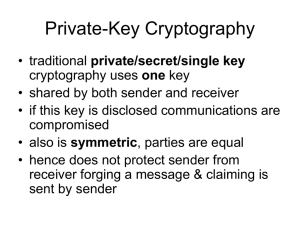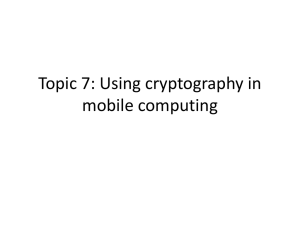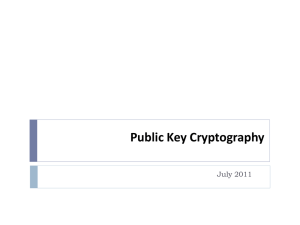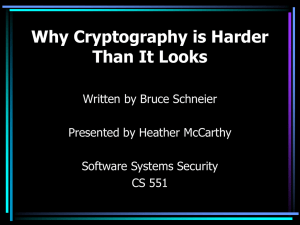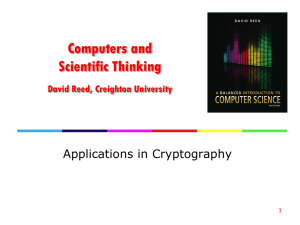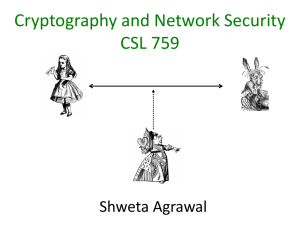The two main branches of public key cryptography
advertisement
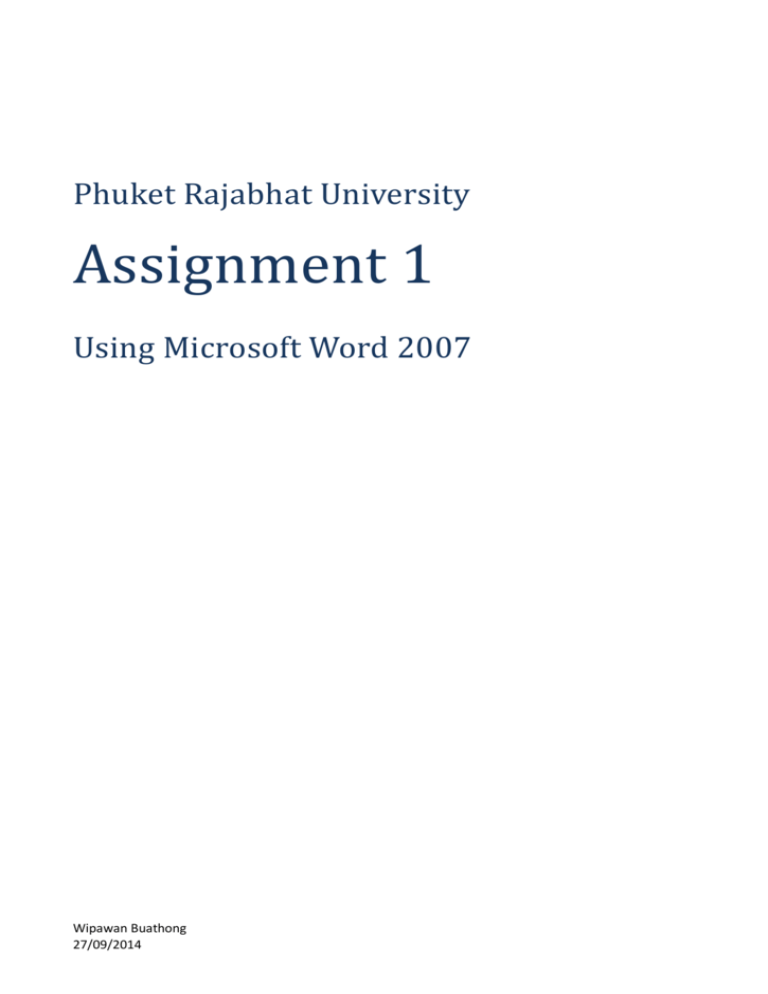
Phuket Rajabhat University Assignment 1 Using Microsoft Word 2007 Wipawan Buathong 27/09/2014 Assignment 1 Using Microsoft Word 2007 Wipawan Buathong PUBLIC-KEY CRYPTOGRAPHY TABLE OF CONTENT HOW IT WORKS ................................................................................................................................................. 3 DESCRIPTION ..................................................................................................................................................... 3 PUBLIC KEY ENCRYPTION ............................................................................................................................... 3 DIGITAL SIGNATURES..................................................................................................................................... 3 TABLE OF FIGURES Figure 1 Public Key Cyptography ....................................................................................................................... 3 Figure 2 Public Key Encryption .......................................................................................................................... 4 Figure 3 Digital Signature .................................................................................................................................. 4 P ublic-key cryptography1 refers to a cryptographic system requiring two separate keys, one to lock or encrypt the plaintext, and one to unlock or decrypt the cyphertext. Neither key will do both functions. One of these keys is published or public and the other is kept private. If the lock/encryption key is the one published then the system enables private communication from the public to the unlocking key's owner. If the unlock/decryption key is the one published then the system serves as a signature verifier of documents locked by the owner of the private key. This cryptographic approach uses asymmetric key algorithms, hence the more general name of "asymmetric key cryptography". Some of these algorithms have the public key / private key property, that is, neither key is derivable from knowledge of the other; not all asymmetric key algorithms do. Those with this property are particularly useful and have been widely deployed and are the source of the commonly used name. The public key is used to transform a message into an unreadable form, decryptable only by using the (different but matching) private key. Participants in such a system must create a mathematically linked key pair (i.e., a public and a private key). By publishing the public key, the key producer empowers anyone who gets a copy of the public key to produce messages only he can read -- because only the key producer has a copy of the private key (required for decryption). When someone wants to send a secure message to the creator of those keys, the 1 From Wikipedia, the free encyclopedia, http://en.wikipedia.org/wiki/Public-key_cryptography 2 Assignment 1 Using Microsoft Word 2007 Wipawan Buathong sender encrypts it (i.e., transforms it into an unreadable form) using the intended recipient's public key; to decrypt the message, the recipient uses the private key. No one else, including the sender can do so. In contrast, symmetric-key algorithms, variations of which have been used for thousands of years, use a single secret key—which must be shared and kept private by both sender and receiver—for both encryption and decryption. To use a symmetric encryption scheme, the sender and receiver must securely share a key in advance. Because symmetric key algorithms are nearly always much less computationally intensive, it is common to exchange a key using a key-exchange algorithm and transmit data using that key and a symmetric key algorithm. PGP, and the SSL/TLS family of schemes do this, for instance, and are thus called hybrid cryptosystems. DESCRIPTION Figure 1 Public Key Cyptography The two main branches of public key cryptography are public key encryption and digital signatures. HOW IT WORKS PUBLIC KEY ENCRYPTION The distinguishing technique used in public key cryptography is the use of asymmetric key algorithms, where the key used to encrypt a message is not the same as the key used to decrypt it. Each user has a pair of cryptographic keys—a public encryption key and a private decryption key. The publicly available encrypting-key is widely distributed, while the private decrypting-key is known only to the recipient. Messages are encrypted with the recipient's public key and can only be decrypted with the corresponding private key. The keys are related mathematically, but parameters are chosen so that determining the private key from the public key is prohibitively expensive. The discovery of algorithms that could produce public/private key pairs revolutionized the practice of cryptography beginning in the middle 1970s. A message encrypted with a recipient's public key cannot be decrypted by anyone except a possessor of the matching private key—presumably, this will be the owner of that key and the person associated with the public key used. This is used for confidentiality. DIGITAL SIGNATURES A message signed with a sender's private key can be verified by anyone who has access to the sender's public key, thereby proving that the sender had access to the private key (and therefore is likely to be the person associated with the public key used), and the part of the message that has not been tampered with. On the question of authenticity, see also message digest. 3 Assignment 1 Using Microsoft Word 2007 Wipawan Buathong Figure 2 Public Key Encryption An analogy to public-key encryption is that of a locked mailbox with a mail slot. The mail slot is exposed and accessible to the public; its location (the street address) is in essence the public key. Anyone knowing the street address can go to the door and drop a written message through the slot; however, only the person who possesses the key can open the mailbox and read the message. An analogy for digital signatures is the sealing of an envelope with a personal wax seal. The message can be opened by anyone, but the presence of the seal authenticates the sender. Figure 3 Digital Signature HISTORY During the early history of cryptography, two parties would rely upon a key using a secure, but noncryptographic, method; for example, a face-to-face meeting or an exchange via a trusted courier. This key, which both parties kept absolutely secret, could then be used to exchange encrypted messages. A number of significant practical difficulties arise in this approach to distributing keys. Public-key cryptography addresses these drawbacks so that users can communicate securely over a public channel without having to agree upon a shared key beforehand. A central problem for use of public-key cryptography is confidence (ideally proof) that a public key is correct, belongs to the person or entity claimed (i.e., is 'authentic'), and has not been tampered with or replaced by a malicious third party. The usual approach to this problem is to use a public-key infrastructure (PKI), in which one or more third parties, known as certificate authorities, certify ownership of key pairs. PGP, in addition to a certificate authority structure, has used a scheme generally called the "web of trust", which decentralizes such authentication of public keys by a central mechanism, substituting individual endorsements of the link between user and public key. No fully satisfactory solution to the public key authentication problem is known. In 1874, a book by William Stanley Jevons described the relationship of one-way functions to cryptography and went on to discuss specifically the factorization problem used to create the trapdoor function in the RSA system. In July 1996, one observer[2] commented on the Jevons book in this way: In his book The Principles of Science: A Treatise on Logic and Scientific Method, written and published in 4 Assignment 1 Using Microsoft Word 2007 Wipawan Buathong the 1890s, William S. Jevons observed that there are many situations where the 'direct' operation is relatively easy, but the 'inverse' operation is significantly more difficult. One example mentioned briefly is that enciphering (encryption) is easy while deciphering (decryption) is not. In the same section of Chapter 7: Introduction titled 'Induction an Inverse Operation', much more attention is devoted to the principle that multiplication of integers is easy, but finding the (prime) factors of the product is much harder. Thus, Jevons anticipated a key feature of the RSA Algorithm for public key cryptography, though he certainly did not invent the concept of public key cryptography. (Ferguson N., 2003) digital signature, and its security is connected to the presumed difficulty of factoring large integers, a problem for which there is no known efficient (i.e., practicably fast) general technique. In 1979 Michael O. Rabin published a related cryptosystem that is probably secure as long as factorization of the public key remains difficult; it remains an assumption that RSA also enjoys this security. Since the 1970s, a large number and variety of encryption, digital signature, key agreement, and other techniques have been developed in the field of public-key cryptography. The ElGamal cryptosystem (invented by Taher ElGamal) relies on the (similar, and related) difficulty of the discrete logarithm problem, as does the closely related DSA developed at the US National Security Agency (NSA) and published by NIST as a proposed standard. The introduction of elliptic curve cryptography by Neal Koblitz and Victor Miller independently and simultaneously in the mid-1980s has yielded new public-key algorithms based on the discrete logarithm problem. Although mathematically more complex, elliptic curves provide smaller key sizes and faster operations for equivalent estimated security. (Katz J., 2007) An asymmetric-key cryptosystem was published in 1976 by Whitfield Diffie and Martin Hellman, who, influenced by Ralph Merkle's work on public-key distribution, disclosed a method of public-key agreement. This method of key exchange, which uses exponentiation in a finite field, came to be known as Diffie–Hellman key exchange. This was the first published practical method for establishing a shared secret-key over an authenticated (but not private) communications channel without using a prior shared secret. Merkle's public-key-agreement technique became known as Merkle's Puzzles, and was invented in 1974 and published in 1978. SECURITY In 1997, it was publicly disclosed that asymmetric key algorithms were developed by James H. Ellis, Clifford Cocks, and Malcolm Williamson at the Government Communications Headquarters (GCHQ) in the UK in 1973.[4] The researchers independently developed Diffie–Hellman key exchange and a special case of RSA. The GCHQ cryptographers referred to the technique as "non-secret encryption". Some encryption schemes can be proven secure on the basis of the presumed hardness of a mathematical problem like factoring the product of two large primes or computing discrete logarithms. Note that "secure" here has a precise mathematical meaning, and there are multiple different (meaningful) definitions of what it means for an encryption scheme to be secure. The "right" definition depends on the context in which the scheme will be deployed. A generalization of Cocks's scheme was independently invented in 1977 by Rivest, Shamir and Adleman, all then at MIT. The latter authors published their work in 1978, and the algorithm appropriately came to be known as RSA. RSA uses exponentiation modulo a product of two large primes to encrypt and decrypt, performing both public key encryption and public key The most obvious application of a public key encryption system is confidentiality; a message which a sender encrypts using the recipient's public key can be decrypted only by the recipient's paired private key (assuming, of course that no flaw is discovered in the basic algorithm used). 5 Assignment 1 Using Microsoft Word 2007 Wipawan Buathong Another type of application in public-key cryptography is that of digital signature schemes. Digital signature schemes can be used for sender authentication and non-repudiation. In such a scheme a user who wants to send a message computes a digital signature of this message and then sends this digital signature together with the message to the intended receiver. Digital signature schemes have the property that signatures can only be computed with the knowledge of a private key. To verify that a message has been signed by a user and has not been modified the receiver only needs to know the corresponding public key. In some cases (e.g. RSA) there exist digital signature schemes with many similarities to encryption schemes. In other cases (e.g. DSA) the algorithm does not resemble any encryption scheme. BIBLIOGRAPHY Ferguson N., S. B. (2003). Practical Cryptography. Willey. Katz J., L. Y. (2007). Introduction to Modern Cryptography. CRC Press. To achieve both authentication and confidentiality, the sender can first sign the message using his private key and then encrypt both the message and the signature using the recipient's public key. These characteristics can be used to construct many other, sometimes surprising, cryptographic protocols and applications, like digital cash, passwordauthenticated key agreement, multi-party key agreement, time stamping service, non-repudiation protocols, etc. Examples of symmetrickey techniques Well-regarded 1. DiffieHellman 2. DSS 3. EIGamal 4. Paillier 5. RSA 6. Cramer-Shoup Not Widely adopted 1. NTRUEncrypt 2. McEliece cryptosystem 6
